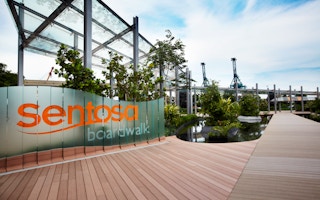Singapore, an island-state with scarce resources yet with a thriving research and development environment, has unveiled its first tidal turbine system on Wednesday.
To continue reading, subscribe to Eco‑Business.
There's something for everyone. We offer a range of subscription plans.
- Access our stories and receive our Insights Weekly newsletter with the free EB Member plan.
- Unlock unlimited access to our content and archive with EB Circle.
- Publish your content with EB Premium.
The Nanyang Technological University (NTU) developed the one-kilowatt turbine test bed and partnered with the Sentosa Development Corporation (SDC) to install the system by the Sentosa Boardwalk, a pedestrian gateway leading to Sentosa Island, a popular tourist destination in the country.
According to the two organisations, this initial tidal energy generator will help Singapore to harness a new renewable energy option that will increase its sources of energy and enhance its energy security. Unlike solar and wind energy, which are susceptible to weather fluctuations, tidal power is more reliable since tidal cycles are predictable.
The International Energy Agency (IEA), however, categorises tidal, solar and wind energy as all variable renewables.
Still, Professor Subodh Mhaisalkar, executive director of Energy Research Institute at NTU (ERI@N), said that investment in emerging technologies and alternative sources of electricity is a demonstration of Singapore’s commitment to increase its use of sustainable energy.
“
One key aspect of our commitment is to open up Sentosa as a test-bed for new green initiatives and technologies, particularly those that can be scaled up for wider adoption across Singapore. This collaboration with NTU has been an exciting project, as it has demonstrated the potential of tidal flow as an alternative energy source
Mike Barclay, SDC CEO
“Apart from proving that tidal energy is feasible in Singapore, the test bed will also provide important research data on how the turbine handles local low-flow currents and the tropical marine environment,” Prof Mhaisalkar added.
The tidal energy generator, built by engineers from the institute, features two low-flow turbines designed especially for local conditions. These prototype turbines are highly efficient in spite of low water speeds in the area, NTU and SDC explained.
Most tidal turbines located in the United Kingdom, France and Canada – countries that have started harnessing tidal energy – make use of fast-flowing water.
The turbines in Singapore will be powered with both low and high tidal currents, the two organisations noted. They explained that the Sentosa Boardwalk is an “ideal location for a tidal power test bed” since the water starts out at a slow speed that then quickens when the water passes through the narrow channels between the concrete pillars supporting the overhead bridge.
The system will be able to generate up to one thousand watts of energy per hour, said NTU and SDC. This is enough to power about 70 fluorescent light bulbs (of 15-watt bulbs) commonly used in households, they noted.
Eventually, the plan will be to scale up the efforts. NTU aims to install more turbines in the future. The data gathered from this initial generator will allow the institute to improve the next systems, said Prof Mhaisalkar. Based on their review, 150 to 200 tidal turbines placed in the southern coastal area of Singapore can power about 5,000 HDB flats.
Currently, the electricity from the trial system is used for the lights of the Sentosa Boardwalk Turbine Exhibit. This is an exhibition on tidal energy – complete with a miniature tidal turbine prototype – that is open to the public.
Mike Barclay, SDC chief executive officer, explained that the exhibit is part of the company’s Sentosa Sustainability Plan, a corporate social responsibility programme. SDC is intent on promoting eco-tourism.
He added: “One key aspect of our commitment is to open up Sentosa as a test-bed for new green initiatives and technologies, particularly those that can be scaled up for wider adoption across Singapore. This collaboration with NTU has been an exciting project, as it has demonstrated the potential of tidal flow as an alternative energy source.”








